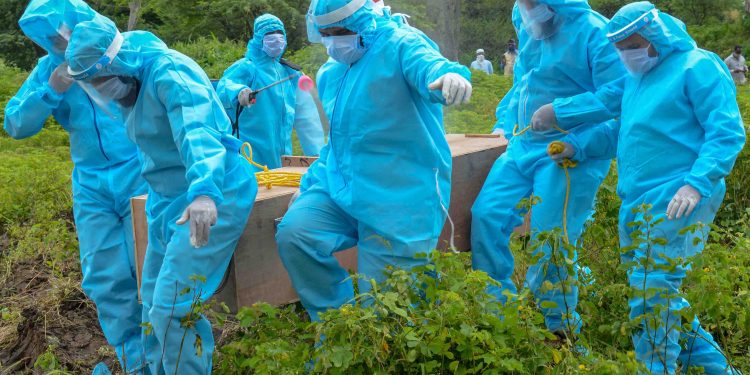Washington: The global death toll from Covid-19 topped 5 million Monday, less than two years into a crisis. The Covid-19 crisis has not only devastated poor countries but also humbled wealthy ones with first-rate health care systems.
Together, the United States, the European Union, Britain and Brazil — all upper-middle-or high-income countries — account for one-eighth of the world’s population but nearly half of all reported deaths. The US alone has recorded over 7,40,000 lives lost, more than any other nation.
“This is a defining moment in our lifetime,” said Dr. Albert Ko, an infectious disease specialist at the Yale School of Public Health. “What do we have to do to protect ourselves so we don’t get to another 5 million?”
The death toll, as tallied by Johns Hopkins University, is about equal to the populations of Los Angeles and San Francisco combined. It rivals the number of people killed in battles among nations since 1950, according to estimates from the Peace Research Institute, Oslo. Globally, Covid-19 is now the third leading cause of death, after heart disease and stroke.
The staggering figure is almost certainly an undercount because of limited testing and people dying at home without medical attention. This has happened especially in poor parts of the world, such as India.
Hot spots have shifted over the 22 months since the outbreak began, turning different places on the world map red. Now, the Covid-19 virus is pummeling Russia, Ukraine and other parts of Eastern Europe. In Ukraine, only 17 per cent of the adult population is fully vaccinated; in Armenia, it is only seven per cent.
“What’s uniquely different about this pandemic is it hit hardest the high-resource countries,” said Dr. Wafaa El-Sadr, director of ICAP, a global health centre at Columbia University. “That’s the irony of Covid-19. Wealthier nations with longer life expectancies have larger proportions of older people, cancer survivors and nursing home residents, all of whom are especially vulnerable to Covid-19, El-Sadr noted. Poorer countries tend to have larger shares of children, teens and young adults, who are less likely to fall seriously ill from the coronavirus.
India, despite its terrifying delta surge that peaked in early May, now has a much lower reported daily death rate. It is better off than Russia, the US or Britain. However, there is uncertainty around its figures.
The seeming disconnect between wealth and health is a paradox that disease experts will be pondering for years. But the pattern that is seen on the grand scale, when nations are compared, is different when examined at closer range. Within each wealthy country, when deaths and infections are mapped, poorer neighbourhoods are hit hardest.
In the US, for example, Covid-19 has taken an outsize toll on Black and Hispanic people. They are people who live in poverty and have less access to health care. “When we get out our microscopes, we see that within countries, the most vulnerable have suffered most,” Ko said.
Wealth has also played a role in the global vaccination drive, with rich countries accused of locking up supplies. The US and others are already dispensing booster shots at a time when millions across Africa haven’t received a single dose, though the rich countries are also shipping hundreds of millions of shots to the rest of the world.
Africa remains the world’s least vaccinated region, with just five per cent of the population of 1.3 billion people fully covered.
In Kampala, Uganda, Cissy Kagaba lost her 62-year-old mother on Christmas Day and her 76-year-old father days later. “Christmas will never be the same for me,” said Kagaba, an anti-corruption activist in the East African country that has been through multiple lockdowns against the virus and where a curfew remains in place.






































